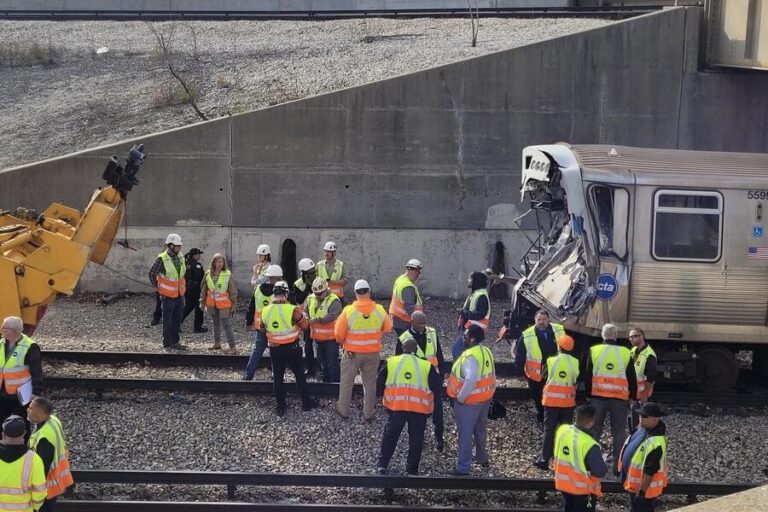The National Transportation Safety Board (NTSB) has concluded its investigation into the 2023 Chicago Transit Authority (CTA) Yellow Line crash, revealing that a combination of reduced braking performance, track conditions, and operational decisions contributed to the accident that sent 16 people to the hospital.
The crash occurred on the morning of November 17, 2023, around 10:30 a.m. The two-car Yellow Line train collided with a snow plow near the Howard rail yard in the Rogers Park neighborhood. At the time of the crash, there were 30 passengers and one operator aboard the train. Six individuals were also on the snow plow. Initial reports indicated that all 38 people on the train had sustained injuries, but the NTSB’s final report clarified that 16 people were treated and released from area hospitals, with three individuals — including the train operator — listed in critical condition.
The investigation identified three primary factors that led to the crash.
The first issue involved the train’s braking system. According to the report, an “aggressive speed reduction command” was given with little warning, causing the train’s wheels to slide and significantly compromising its ability to stop. The sudden braking reduced friction between the wheels and the rails, making it difficult for the operator to control the train in time to avoid the collision.
The second factor was related to a decision by the CTA to disable the automatic track brake operation feature on the train. This safety feature is designed to help slow down or stop a train when emergency braking is required. However, with this feature deactivated, the train’s braking performance was further delayed, worsening the situation.
The final factor cited by the NTSB was the condition of the tracks. Fallen leaves created slippery rail conditions, which further hampered the train’s ability to brake effectively. Leaf residue, when crushed under train wheels, can form a slippery coating on tracks, a problem that has been known to affect rail systems in various parts of the country during autumn months.
The report also addressed a previously raised concern regarding the train operator’s alcohol levels. Hospital testing revealed that the 47-year-old operator had a blood alcohol concentration (BAC) of .06, above the legal limit of .02 for train operators. However, the NTSB concluded that alcohol was not a contributing factor in the crash. Despite the elevated BAC, investigators found that the critical factors leading to the incident were related to operational and environmental conditions.
The crash caused $8.7 million in damages and led to a seven-week suspension of service on the CTA Yellow Line, also known as the Skokie Swift. Service did not resume until January 2024, leaving commuters in the area without their usual transportation options for nearly two months.
The findings have prompted discussions about improving safety measures for public transit systems. The report highlights the importance of maintaining automatic safety features like track brakes and addressing seasonal hazards such as slippery rails. Experts note that transit agencies must balance operational efficiency with safety, especially in situations where unpredictable conditions, such as fallen leaves, can impact performance.
For passengers who were aboard the train that day, the crash was a traumatic experience. Maria Gonzalez, a commuter who frequently rides the Yellow Line, recalled the chaos that unfolded during the incident. “One moment everything seemed normal, and the next there was this loud screech and then a jolt. People were thrown forward. It was terrifying,” she said.
The CTA has faced scrutiny for its decision to disable the automatic track brake feature, with critics arguing that doing so compromised passenger safety. In response to the report, a CTA spokesperson acknowledged the findings and stated that the agency is reviewing its safety protocols to prevent similar incidents in the future.
“We take the NTSB’s recommendations seriously and are committed to enhancing our safety measures. Our top priority is ensuring the well-being of our passengers and operators,” the spokesperson said.
The NTSB’s investigation serves as a reminder of the complex factors that can lead to accidents on public transit systems. John Carmichael, a rail safety expert, emphasized the importance of maintaining both technology and infrastructure. “Automatic braking systems exist for a reason,” he said. “When you disable critical safety features, you’re increasing the risk of incidents like this.”
Transit agencies across the country have faced similar challenges with slippery rail conditions, particularly in the fall. The accumulation of crushed leaves can reduce traction, making it harder for trains to stop. Several cities have implemented measures to address this issue, such as using rail-cleaning vehicles or applying sand to improve traction.
Moving forward, the NTSB recommends that the CTA and other transit authorities ensure that safety features remain operational and that staff receive adequate training on how to handle sudden speed reduction commands. Additionally, the report underscores the importance of monitoring environmental conditions that could affect rail performance.
For the passengers and crew involved in the 2023 Yellow Line crash, the findings offer some closure but also raise questions about accountability and future safety improvements. Many hope that lessons learned from the incident will lead to more robust safety protocols and investments in transit infrastructure.
As the CTA works to implement changes based on the NTSB’s recommendations, passengers are reminded of the critical role safety measures play in ensuring reliable and secure public transportation. The incident serves as a stark example of how small factors—such as leaves on the tracks—can have major consequences when compounded by human and technical errors.
The Yellow Line crash remains one of the most significant incidents in the recent history of the Chicago Transit Authority, prompting renewed focus on safety across the entire transit system. For now, commuters can only hope that improvements will help prevent similar accidents in the future.
